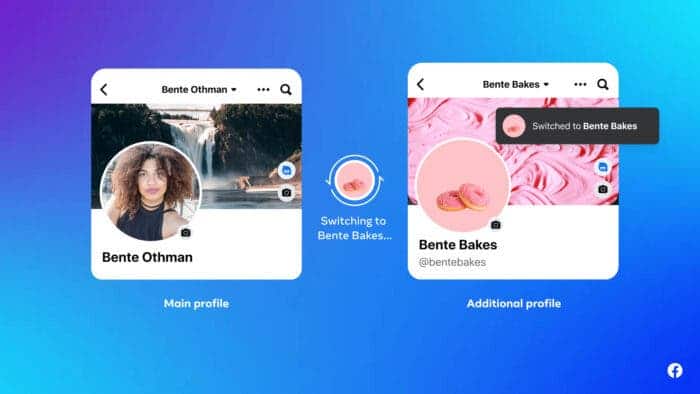In a surprising move that diverges from its long-standing policies, Facebook has ushered in a new era of user customization by allowing individuals to create multiple user profiles within the same account. Until recently, users had to resort to various workarounds, such as creating pages or entirely new accounts with different email addresses, to achieve a semblance of separation between their online identities. However, Facebook’s latest innovation enables users to seamlessly manage distinct profiles, each with its own circle of friends and a personalized user experience. This article delves into the implications of this groundbreaking feature. Exploring how it transforms the way we interact and share content on the platform.
Facebook’s New Era: Multiple User Profiles and Personalization
For years, Facebook vehemently opposed the idea of users having multiple accounts, implementing identity verification and numerous obstacles to deter individuals from creating more than one profile. However, the platform has undergone a significant transformation by embracing the concept of multiple user profiles. Mirroring the functionality already offered by its subsidiary, Instagram.
The need for this change becomes evident when we consider the complexity of modern life. We often find ourselves in situations where we don’t wish to share the same content with different groups of people. For instance, you may not want to post or comment on the same topics when your boss, family members, and friends are all part of your social network. Historically, Facebook attempted to address this issue through privacy settings and exclusion lists, which, while helpful, sometimes proved to be cumbersome and challenging to manage.
Now, Facebook offers an alternative solution: instead of navigating intricate privacy settings, users can simply create multiple profiles tailored to their different identities. This approach allows for a more straightforward way of managing your online presence. Imagine having a professional profile for your coworkers, another for your close friends, and yet another for your family members.
Creating Multiple Profiles

Creating multiple profiles on Facebook is now a straightforward process. Significantly easier than the previous methods of creating pages or starting new accounts from scratch. The process can be completed in just a couple of steps.
- Account Selector: To get started, click the arrow next to your name in the Facebook menu and select “Create new profile.”
- Profile Customization: Next, you can choose a name and username for your new profile, as well as select a profile and cover photo. This initial setup allows you to establish the identity of your secondary profile.
Once you’ve completed these steps, your secondary profile is ready, and Facebook will guide you through additional settings. You can choose to follow friends from your primary account, receive suggestions for groups and pages to join, and review your privacy settings to ensure that your secondary profile aligns with your preferences.
One notable aspect of this feature is that your secondary profile remains entirely separate from your primary account. With no visible indication of their connection. However, it’s important to note that certain features available in primary accounts, such as the dating section, Marketplace, professional mode, and payments, may not be accessible in secondary accounts.
A Closer Look at the Benefits
Let’s delve deeper into the benefits of Facebook’s multiple user profiles:
- Enhanced Control: The ability to maintain separate profiles empowers users to exercise greater control over their online presence. It allows for finely-tuned privacy settings, making it easier to share personal updates with close friends while keeping professional contacts at arm’s length.
- Reduced Social Pressure: Traditional single-profile Facebook accounts often lead to a sense of social pressure to maintain a specific image. Multiple user profiles alleviate this pressure by allowing individuals to express different aspects of their personality.
- Improved Content Relevance: Tailoring profiles to specific groups fosters a more enjoyable browsing experience. You won’t have to sift through unrelated content to find what matters most to you.
- Seamless Networking: For professionals, the ability to create a dedicated profile for networking is a game-changer. It facilitates focused networking while preserving the personal and social aspects of the platform.
- Reduced Clutter: Keeping different aspects of your life separate reduces the clutter and noise in your feed. Making it easier to focus on what’s most important at any given moment.
Addressing Concerns
Despite the numerous advantages of multiple user profiles on Facebook, there are also some potential concerns that need to be considered:
- Identity Confusion: With multiple profiles, there’s a risk of identity confusion. Users might forget which profile they’re currently using, leading to unintentional posts or interactions with the wrong audience.
- Privacy Risks: While multiple profiles offer enhanced privacy, they also present the risk of accidentally sharing sensitive information with the wrong group. Users must remain vigilant in managing their profiles and settings.
- Content Overlap: There may be instances where content overlaps between profiles, leading to redundancy. Users must be mindful of this and employ effective content management strategies.
- Algorithmic Challenges: Facebook’s algorithms may face challenges in accurately categorizing and curating content for multiple profiles, potentially affecting the user experience.
- Monitoring and Management: Maintaining multiple profiles can be demanding, requiring diligent monitoring and management to ensure each profile serves its intended purpose effectively.

Future Implications
The introduction of multiple user profiles on Facebook has the potential to influence the broader social media landscape. As other platforms observe the success and user satisfaction resulting from this innovation, they may consider implementing similar features. This competition could lead to even more advanced customization options and improved user experiences across various social media platforms.
Additionally, the way we think about online identity and privacy is evolving. Facebook’s move towards user-driven customization reflects a growing awareness of the importance of individual agency and control in the digital world. It encourages users to take ownership of their online personas and interactions. Paving the way for a more conscious and thoughtful online experience.
Conclusion
Facebook’s decision to allow users to create multiple profiles within a single account marks a significant departure from its previous stance on the matter. This innovative feature empowers users to navigate the complexities of modern life by offering a more versatile and user-friendly platform. With the ability to tailor their online identities to various facets of their lives, users can enjoy enhanced privacy, streamlined interactions, and a more personalized experience.
As we embrace this new era of Facebook, it’s essential to recognize the benefits of this feature while also being mindful of its limitations. While it simplifies online interactions and content sharing, it’s crucial to use these multiple profiles responsibly and ethically. Ensuring that the boundaries between different aspects of our lives remain intact.
Ultimately, Facebook’s move towards accommodating multiple user profiles reflects its commitment to adapt and evolve with changing user needs. This shift provides a glimpse into the future of social media. Where platforms become even more versatile and attuned to the complexities of our multifaceted lives.





